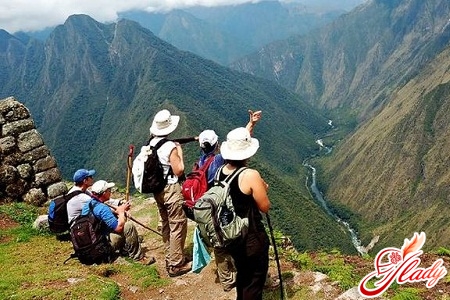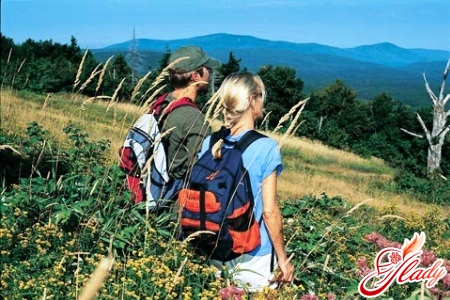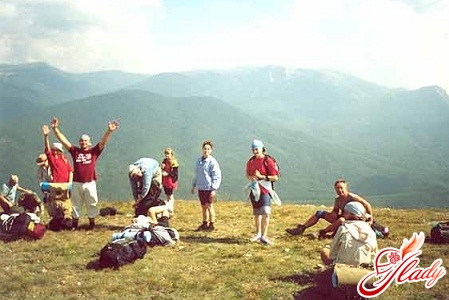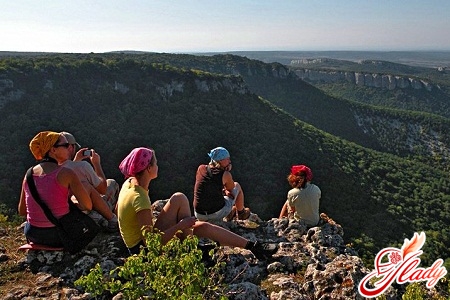 Summer is the time for active recreation, vacations andentertainment. Every year, many people have to pack bulky suitcases to go on vacation, for example, to the sea. But with a hike, everything is much more complicated. What to take on a hike to make your vacation as comfortable as possible with a minimum set of things? Let's figure this out together. When going on a hike, it is important to take into account the main requirement: the backpack should be as roomy and comfortable as possible with minimal external dimensions. The capacity of hiking backpacks is measured in liters. In this case, the ideal backpack is one with a capacity of 50-70 liters. The backpack should be made of strong, dense fabric, its bottom should be sewn in, and the shoulder straps should be securely attached. Before you decide what you need to take on a hike, understand one rule. Things in the backpack should be packed like this:
Summer is the time for active recreation, vacations andentertainment. Every year, many people have to pack bulky suitcases to go on vacation, for example, to the sea. But with a hike, everything is much more complicated. What to take on a hike to make your vacation as comfortable as possible with a minimum set of things? Let's figure this out together. When going on a hike, it is important to take into account the main requirement: the backpack should be as roomy and comfortable as possible with minimal external dimensions. The capacity of hiking backpacks is measured in liters. In this case, the ideal backpack is one with a capacity of 50-70 liters. The backpack should be made of strong, dense fabric, its bottom should be sewn in, and the shoulder straps should be securely attached. Before you decide what you need to take on a hike, understand one rule. Things in the backpack should be packed like this:
- Heavy should be laid down or middle, as close as possible to the back.
- Soft - only to the back.
- Fragile and voluminous - upstairs.
- Items of essentials should be placed in the pockets of the backpack. And it is important to remember their location in the backpack to quickly get them when they are needed.
- Things should be stacked in such a way that when walking, nothing thundered.
Experienced tourists recommend going to bed firsta backpack, a rolled-up mat to shape the backpack, and a plastic bag to protect things from moisture. After that, it is better to pack a blanket or sleeping bag, then other large and soft things. Then you should pack food - canned goods, cereals, sugar, etc., and then - essentials. Personal items should be laid out in cloth or waterproof bags. After packing the things needed for the hike, you should put the backpack on your back to check how comfortable it sits on your back. If the backpack is packed correctly, then it will fit very tightly with the concave side to your back. Large items should not be fastened to the bottom of the backpack or on the outside. In some cases, of course, this is impossible. After all, items such as a tent and a sleeping bag are quite problematic to fit into a backpack, so they should be wrapped in waterproof material beforehand and tightly tied to the backpack. Before you start packing your backpack, you need to write a list of things you need for the hike, and you should think it through very carefully so as not to take too much with you and not forget what you need. To begin with, you should discuss with the other participants in the hike who carries what from the common items, so as not to duplicate items and not drag extra weight. That is, it is enough for one of the whole group to take one tube of toothpaste, one soap, etc. If you correctly discuss who takes what, you can get rid of 2-3 extra kilograms of weight. You can do the same with food. You should discuss in advance what food to take on the hike for each of its participants. And now you can start writing a list of things needed for the hike.
We collect kitchen utensils
So, first of all, let's figure out what kind of dishesshould be taken with you. You should not take breakable dishes with you. First of all, you need to take a mug, knife, spoon and bowl. Moreover, it is best to choose aluminum spoons for the hike - they are light and can be used many times. It is preferable to choose a mug made of food-grade plastic - it is not only light, but also does not heat up like metal mugs. Bowls should be taken, like spoons, aluminum. Of course, you can use plastic ones, but in field conditions such dishes are quite difficult to wash off grease. Also, among the participants of the hike there should be one large bowl in which you can prepare a salad for the whole group. If 10-12 people are going on a hike, then the whole group should take no more than 3-4 knives. Moreover, the knives must be packed in covers to avoid accidental injuries and damage to backpacks. Also, do not forget to take one ladle for the whole group of people. For a large group of people (10-16 people), you need to take at least two cauldrons. If the group is small (3-4 people), then it is quite possible to get by with 1 boiler. In addition, boilers can be replaced with aluminum pots, the handles of which should be sawed off, and in their place drill holes into which you will need to thread a metal cable. The length of the cable should be equal to half the perimeter of the pot. For a small group of people, one 2- and 4-liter pot will do. For an average group (6-8 people), 5-liter and 7-liter boilers are needed. But for a large group, you can make boilers from canisters with a volume of 10 liters. It is important that the canisters are made of food aluminum. What else should you take on a hike from the dishes? Of course, a frying pan. Thanks to the presence of a frying pan in the group, you can cook not only more delicious soups, making a frying on it, but also fry various pancakes and fritters. It is best to take a frying pan with a Teflon coating and a removable handle on a hike.
We collect first-aid kit
When making a list of what to take on a hike,It is worth remembering that accidents sometimes happen on hikes. Someone may break something, someone may cut themselves, someone may eat something, and someone may simply catch a cold. In this case, it is important that the group has a first aid kit with everything necessary to provide first aid. So, what to take on a hike: a list of necessary items in the first aid kit:
- Sterile and non-sterile bandages.
- Harness.
- Elastic bandage.
- Iodine.
- Bactericidal plaster.
- Plaster in a roll.
- Hydrogen peroxide.
- Vata.
- Potassium permanganate.
- Panthenol.
- Sofradex or Albucid.
- Validol.
- Citramon.
- Baralgin, analgin, spazgan or ketorol.
- Suprastin or fenkarol.
- Bellallin.
- But-shpa.
- Scissors.
- Activated carbon.
In addition, when going on a hike, you should askall its participants, whether they tolerate certain medications or not. If someone has an intolerance to a certain medication, it is best if he himself purchases the appropriate medications for the hike.
We collect food for the hike
So, the main things needed for the hike are alreadycooked. Now it's time to think about what you're going to eat. Of course, you shouldn't take perishable foods under any circumstances. But a variety of canned goods is what you need. Before deciding what food to take on a hike, study the hiking route. This is very important, since the quantity and list of products depends primarily on whether you'll come across populated areas with stores along the way. After all, you can buy some of the products there. But if the hiking route goes through uninhabited areas, you should stock up on food for the entire hike. Moreover, the longer the hike is planned, the more food you should take. In addition, each person in the group should have an "emergency supply" in case the calculations turn out to be incorrect and the food runs out ahead of time. You should forget about home-cooked food during the hike, because people don't go on a hike to eat. Food on a hike is needed primarily to restore and maintain strength. During a hike, it is important to replenish carbohydrates in the body. Cereals are rich in them. Therefore, you should take with you such cereals as: rice, buckwheat, pearl barley, pasta. You can also take meat products. This can be dried, cured or canned meat. The ideal option is stewed meat. You can also grab sausage, but only dry-cured sausage, which is packed in a vacuum package. For vegetarians, you can take peas, mung beans, beans or soybeans in cooked or dry form. Of course, it is best to take dry products, since they have more nutrients. Also from dry products you can take dried vegetables, dried fruits, dried mushrooms and herbs, nuts, dry milk. So, the main thing that you need to take on a hike from products has been determined. Now you can think about what "goodies" to take on a hike. You can take candies, cookies, condensed milk. It also does not hurt to take mint or sour lozenges. A good hiking sweet is honey. So, now let's briefly consider what you need to take on a week's hike from products, calculated per person:
- Groats (any) - about 1 kg.
- Beans - 0,2-0,3 kg.
- Meat - 0,2 kg. If the meat is dried - then 0.1 kg.
- Muesli - 0.3 kg.
- Dried mushrooms and vegetables - 0.3 kg.
- Milk powder - 0,2 kg.
- Sweets - a little bit of everything.
- Tea brew or coffee - according to the needs of the person.
- Salt and spices.
- Dried fruits and nuts - 0.3 kg.
And, of course, the most important thing on any hikeis water. You can’t cook anything without water – neither soup, nor porridge, nor tea. You can’t take a lot of water on a long hike, so the route should be laid out in such a way that there are natural sources of drinking water (for example, springs) or settlements along the way where you can replenish your supplies of this valuable liquid. Plastic bottles are best suited for the hike, and you should pour water into them. If you run out of water during the hike, and the next place to replenish supplies is still far away – in no case replace water with alcoholic beverages. This can cause dehydration.
Other necessary things in the hike
In addition to all of the above, take on a hikeYou should also take such things as an axe and a saw. With an axe you can chop wood for a fire. But a saw will come in handy for sawing convenient logs that can successfully replace chairs by the fire. Moreover, both the axe and the saw should be carried in a case to avoid injury to any of the participants in the hike. So, we have considered all the basics. Now let's talk about clothes and other little things. Let's decide what else to take on a hike: a list of everything else that is also no less important during a hike is briefly presented below:
- 2-3 sets of underwear. It is best to take thermal underwear, because often the nights are very cool.
- 2-3 pairs of thin socks and 1-2 pairs of warm socks.
- Very warm sweater.
- T-shirt. You can two, but not more.
- Shorts.
- A warm sweatshirt. And it is important that the hoody was with a hood.
- Jeans.
- Non-blowing jacket.
- Rubber boots.
- Old sneakers.
- Headgear (cap, panama or straw hat).
- Camera.
- Means of personal hygiene (toothbrush, soap, toothpaste, toilet paper).
- Means for sunburn.
- Wet wipes (including for intimate hygiene).
- Hygienic lipstick.
- Towel.
- Swimsuits (swimsuit). Will be useful, if the hike is at the height of summer, you can swim somewhere.
- Fishing rod. If there are ponds, lakes or rivers on the itinerary, then you can go fishing. Ear at the stake is
- terribly delicious!
- Remedy against mosquitoes.
- Guitar. The gathering in the evening at the campfire to the sound of a guitar - wonderful memories for a long time.
- Flashlight.
That's all you'll need for the hike. Have a great vacation! We recommend reading:









